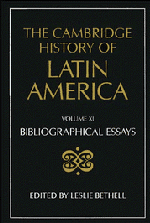Book contents
- Frontmatter
- I THE INDIGENOUS PEOPLES OF MIDDLE AND SOUTH AMERICA ON THE EVE OF THE CONQUEST
- II COLONIAL SPANISH AMERICA
- 1 The Spanish conquest and settlement of America
- 2 Indian societies and the Spanish conquest
- 3 Spain and America in the sixteenth and seventeenth centuries
- 4 Spain and America: The Atlantic trade, 1492–c.1720
- 5 Spain and America in the eighteenth century
- 6 Population
- 7 Urban development
- 8 Mining
- 9 The formation and economic structure of the hacienda in New Spain
- 10 The rural economy and society of Spanish South America
- 11 Aspects of the internal economy: Labour, taxation, distribution and exchange
- 12 Social organization and social change
- 13 Indian societies under Spanish rule
- 14 Africans in Spanish American colonial society
- 15 Women in Spanish American colonial society
- 16 The Catholic church
- 17 Literature and intellectual life
- 18 Architecture and art
- 19 Music
- III COLONIAL BRAZIL
- IV THE INDEPENDENCE OF LATIN AMERICA
- V LATIN AMERICA: ECONOMY, SOCIETY, POLITICS, c. 1820 TO c. 1870
- VI LATIN AMERICA: ECONOMY, SOCIETY, POLITICS, c. 1870 to 1930
- VII LATIN AMERICA: ECONOMY, SOCIETY, POLITICS, 1930 to c. 1990
- VIII IDEAS IN LATIN AMERICA SINCE INDEPENDENCE
- IX LATIN AMERICAN CULTURE SINCE INDEPENDENCE
- X THE INTERNATIONAL RELATIONS OF LATIN AMERICA SINCE INDEPENDENCE
- THE CAMBRIDGE HISTORY OF LATIN AMERICA
9 - The formation and economic structure of the hacienda in New Spain
from II - COLONIAL SPANISH AMERICA
Published online by Cambridge University Press: 28 March 2008
- Frontmatter
- I THE INDIGENOUS PEOPLES OF MIDDLE AND SOUTH AMERICA ON THE EVE OF THE CONQUEST
- II COLONIAL SPANISH AMERICA
- 1 The Spanish conquest and settlement of America
- 2 Indian societies and the Spanish conquest
- 3 Spain and America in the sixteenth and seventeenth centuries
- 4 Spain and America: The Atlantic trade, 1492–c.1720
- 5 Spain and America in the eighteenth century
- 6 Population
- 7 Urban development
- 8 Mining
- 9 The formation and economic structure of the hacienda in New Spain
- 10 The rural economy and society of Spanish South America
- 11 Aspects of the internal economy: Labour, taxation, distribution and exchange
- 12 Social organization and social change
- 13 Indian societies under Spanish rule
- 14 Africans in Spanish American colonial society
- 15 Women in Spanish American colonial society
- 16 The Catholic church
- 17 Literature and intellectual life
- 18 Architecture and art
- 19 Music
- III COLONIAL BRAZIL
- IV THE INDEPENDENCE OF LATIN AMERICA
- V LATIN AMERICA: ECONOMY, SOCIETY, POLITICS, c. 1820 TO c. 1870
- VI LATIN AMERICA: ECONOMY, SOCIETY, POLITICS, c. 1870 to 1930
- VII LATIN AMERICA: ECONOMY, SOCIETY, POLITICS, 1930 to c. 1990
- VIII IDEAS IN LATIN AMERICA SINCE INDEPENDENCE
- IX LATIN AMERICAN CULTURE SINCE INDEPENDENCE
- X THE INTERNATIONAL RELATIONS OF LATIN AMERICA SINCE INDEPENDENCE
- THE CAMBRIDGE HISTORY OF LATIN AMERICA
Summary
The study of the hacienda as a productive unit in the creation of new forms of exploitation of the soil and of labour is a relatively recent phenomenon in Mexico. Lesley B. Simpson, Exploitation of Land in Central Mexico in the Sixteenth Century (Berkeley and Los Angeles, 1952) illustrates with quantitative data the impressive, early conversion of Indian lands into agricultural and stock-raising enterprises owned and run by Spaniards. François Chevalier, La formation des grands domaines au Mexique (Paris, 1952; Sp. ed., 1956; Eng. ed., Land and Society in Colonial Mexico: The Great Hacienda, Berkeley and Los Angeles, 1966) continued the traditional interest in forms of land tenure – for example Helen Phipps, Some Aspects of the Agrarian Question in Mexico (Austin, Tex., 1925); George McCutchen McBride, The Land Systems of Mexico (New York, 1923); Silvio Zavala, De encomienda y propiedad territorial en algunas regiones de la América espanola (Mexico, D.F., 1940; reprinted in Estudios Indianos, Mexico, D.F., 1948; 2nd ed., 1984); Jesús Amaya Tapete, Ameca: Protofundacidn mexicana (Mexico, D.F., 1951) – and gave a new dimension to studies on land ownership and agriculture. Using a wide variety of private and official archives, Chevalier reconstructed the main processes which influenced the formation of the latifundia, traced their development over time, and related the expansion of the hacienda to the general development of the colony and in particular to the establishment of a new economic structure.
- Type
- Chapter
- Information
- The Cambridge History of Latin America , pp. 82 - 89Publisher: Cambridge University PressPrint publication year: 1995



